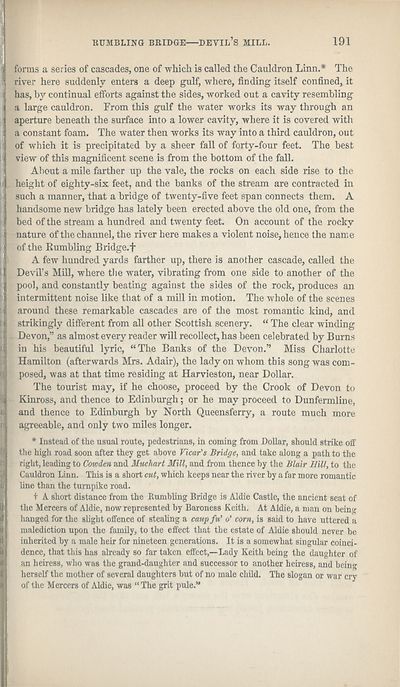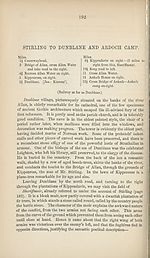Download files
Complete book:
Individual page:
Thumbnail gallery: Grid view | List view

BUMBLING BRIDGE—DEVIL’S MILL.
191
forms a series of cascades, one of which is called the Cauldron Linn.* The
river here suddenly enters a deep gulf, where, finding itself confined, it
has, by continual efforts against the sides, worked out a cavity resembling
a large cauldron. From this gulf the water works its way through an
aperture beneath the surface into a lower cavity, where it is covered with
a constant foam. The water then works its way into a third cauldron, out
of which it is precipitated by a sheer fall of forty-four feet. The best
view of this magnificent scene is from the bottom of the fall.
About a mile farther up the vale, the rocks on each side rise to the
height of eighty-six feet, and the banks of the stream are contracted in
such a manner, that a bridge of twenty-five feet span connects them. A
handsome new bridge has lately been erected above the old one, from the
bed of the stream a hundred and twenty feet. On account of the rocky
nature of the channel, the river here makes a violent noise, hence the name
of the Rumbling Bridge.f
A few hundred yards farther up, there is another cascade, called the
Devil’s Mill, where the water, vibrating from one side to another of the
pool, and constantly beating against the sides of the rock, produces an
intermittent noise like that of a mill in motion. The whole of the scenes
around these remarkable cascades are of the most romantic kind, and
strikingly different from all other Scottish scenery. “ The clear winding
Devon,” as almost every reader will recollect, has been celebrated by Burns
in his beautiful lyric, “The Banks of the Devon.” Miss Charlotte
Hamilton (afterwards Mrs. Adair), the lady on whom this song was com¬
posed, was at that time residing at Harvieston, near Dollar.
The tourist may, if he choose, proceed by the Crook of Devon to
Kinross, and thence to Edinburgh; or he may proceed to Dunfermline,
and thence to Edinburgh by North Queensferry, a route much more
agreeable, and only two miles longer.
* Instead of the usual route, pedestrians, in coming from Dollar, should strike off
the high road soon after they get above Vicar’s Bridge, and take along a path to the
right, leading to Camden and Muchart Mill, and from thence by the Blair Hill, to the
Cauldron Linn. This is a short cut, which keeps near the river by a far more romantic
line than the turnpike road.
t A short distance from the Rumbling Bridge is Aldie Castle, the ancient seat of
the Mercers of Aldie, now represented by Baroness Keith. At Aldie, a man on being
hanged for the slight offence of stealing a canpfu’ o’ corn, is said to have uttered a
malediction upon the family, to the effect that the estate of Aldie should never be
inherited by a male heir for nineteen generations. It is a somewhat singular coinci¬
dence, that this has already so far taken effect,—Lady Keith being the daughter of
an heiress, who was the grand-daughter and successor to another heiress, and being
herself the mother of several daughters but of no male child. The slogan or war cry
of the Mercers of Aldie, was "The grit pule.”
191
forms a series of cascades, one of which is called the Cauldron Linn.* The
river here suddenly enters a deep gulf, where, finding itself confined, it
has, by continual efforts against the sides, worked out a cavity resembling
a large cauldron. From this gulf the water works its way through an
aperture beneath the surface into a lower cavity, where it is covered with
a constant foam. The water then works its way into a third cauldron, out
of which it is precipitated by a sheer fall of forty-four feet. The best
view of this magnificent scene is from the bottom of the fall.
About a mile farther up the vale, the rocks on each side rise to the
height of eighty-six feet, and the banks of the stream are contracted in
such a manner, that a bridge of twenty-five feet span connects them. A
handsome new bridge has lately been erected above the old one, from the
bed of the stream a hundred and twenty feet. On account of the rocky
nature of the channel, the river here makes a violent noise, hence the name
of the Rumbling Bridge.f
A few hundred yards farther up, there is another cascade, called the
Devil’s Mill, where the water, vibrating from one side to another of the
pool, and constantly beating against the sides of the rock, produces an
intermittent noise like that of a mill in motion. The whole of the scenes
around these remarkable cascades are of the most romantic kind, and
strikingly different from all other Scottish scenery. “ The clear winding
Devon,” as almost every reader will recollect, has been celebrated by Burns
in his beautiful lyric, “The Banks of the Devon.” Miss Charlotte
Hamilton (afterwards Mrs. Adair), the lady on whom this song was com¬
posed, was at that time residing at Harvieston, near Dollar.
The tourist may, if he choose, proceed by the Crook of Devon to
Kinross, and thence to Edinburgh; or he may proceed to Dunfermline,
and thence to Edinburgh by North Queensferry, a route much more
agreeable, and only two miles longer.
* Instead of the usual route, pedestrians, in coming from Dollar, should strike off
the high road soon after they get above Vicar’s Bridge, and take along a path to the
right, leading to Camden and Muchart Mill, and from thence by the Blair Hill, to the
Cauldron Linn. This is a short cut, which keeps near the river by a far more romantic
line than the turnpike road.
t A short distance from the Rumbling Bridge is Aldie Castle, the ancient seat of
the Mercers of Aldie, now represented by Baroness Keith. At Aldie, a man on being
hanged for the slight offence of stealing a canpfu’ o’ corn, is said to have uttered a
malediction upon the family, to the effect that the estate of Aldie should never be
inherited by a male heir for nineteen generations. It is a somewhat singular coinci¬
dence, that this has already so far taken effect,—Lady Keith being the daughter of
an heiress, who was the grand-daughter and successor to another heiress, and being
herself the mother of several daughters but of no male child. The slogan or war cry
of the Mercers of Aldie, was "The grit pule.”
Set display mode to:
![]() Universal Viewer |
Universal Viewer | ![]() Mirador |
Large image | Transcription
Mirador |
Large image | Transcription
| Antiquarian books of Scotland > Scotland/Scots > Black's picturesque tourist of Scotland > (271) |
|---|
| Permanent URL | https://digital.nls.uk/130031442 |
|---|
| Description | Thousands of printed books from the Antiquarian Books of Scotland collection which dates from 1641 to the 1980s. The collection consists of 14,800 books which were published in Scotland or have a Scottish connection, e.g. through the author, printer or owner. Subjects covered include sport, education, diseases, adventure, occupations, Jacobites, politics and religion. Among the 29 languages represented are English, Gaelic, Italian, French, Russian and Swedish. |
|---|

